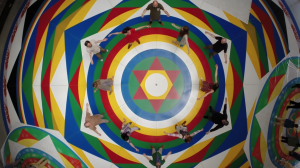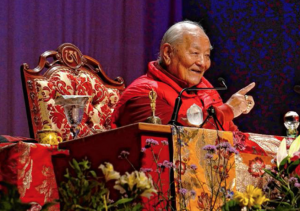Listen To Our Podcast Here
An Introduction to Dzogchen Practice
We all battle over wether our cup is half full or half empty, but what if, instead, we just drank all the water and saw our cup as totally empty? Our lives seem too overflow with suffering –past suffering, present suffering, the suffering of others, and the suffering we anticipate. So, how do we begin to understand and accept this half full, half empty, overflowing cup of life? If you’ve come across this podcast, then get ready to hold a Buddhist’s kind of cup.
Buddhist practice is about how we discover, understand and accept the causes of what hurts us in life. But what does it mean to accept suffering? And, how do we go about making this mindset a more natural state of being? This kind of existence is possible, and you can start to understand it right now.
We sat down with Gerry Steinberg, a practicing Buddhist, from the Tsegyalgar Dzogchen Center in Conway, MA. Gerry has 40 years of experience in Dzogchen practice under his belt. So, we were eager to ask about how buddhist practice provides him with a deeper understanding of life.

When we first met Gerry he was walking up the steps to Neilson Library where we had asked him to meet for our interview, and with an enthusiastic gait he greeted us under the cool shade cast by the building. As we walked out into the sun towards the back entrance of the building, we noticed his sneakers. Sporting moderately worn running shoes and a fanny pack, he told us that in fact he had walked from home and would be returning by foot as well. This surprised me given that Gerry is in his seventies, yet is evidently more active than we are at 20. As we heaved the door to the small recording room closed, Gerry told us about his work as a doctor and how walking is part of something called zone two training. It was clear to us that this practice was meaningful to him, and that he thoroughly understood the mechanics behind it. As the interview continued his dedication and thorough understanding of the exercise made clear parallels to his experience in the practice of Dzogchen.
Prior to meeting with Gerry, we got a small taste of Dzogchen practice. We attended one of the Tsegyalgar Dzogchen Center’s practices via zoom, and were greeted by Mariano Gill who led that evening’s session. As about 16 members poured into the call, all very friendly and happy to see one another, we muted ourselves and watched as they began a synchronized chant. Their sound was songlike. Then, the practitioners began breathing together in rhythm while gesturing their hands. One of these motions had the hand centered in front of the chest as it weaved side to side, imitating a stream of water. The breathing and movements continued for about an hour, and every so often Mariano would, subtly, ring a small bell. Towards the end of the practice everybody produced a bowl and cup from which they ate and drank together in silence. Everything about the practice had an organic flow, eliciting a kind of calmness that made us feel welcomed into this intimate space.

There was an apparent common understanding among everybody. Mariano had been adjusting his zoom camera before the practice began but had an issue with some glare reflected off a large mirror above and behind him on a fireplace mantel. He noted something along the lines of “Oh, it appears I have a moon here” and that he would fix it by repositioning a light in the room. It prompted a few chuckles from the rest of the group which made us suspect this playful inside joke was referencing the well-known Buddhist “moon in the water” analogy. This analogy has many interlocking meanings, but most significantly it serves to explain how something can be observed that does not itself exist.
To the monkey, the moon appears to be in the water. However, when he reaches out to grasp the moon, he finds it is just an illusion and as the branch above him breaks, he falls in. Just as how there appears to be a moon in the water, but is not, phenomena, including our own minds, appear to exist intrinsically, but do not. And just as we can explain the appearance of the moon through the reflective power of the water, we can explain the appearance of intrinsic existence through the mind’s tendency to superimpose intrinsic reality onto things that lack it. This idea that phenomena do not have intrinsic existence, coupled with the realization that all phenomena are merely temporary is called “emptiness”.
In our discussion, Gerry not only explained emptiness, but also significant Buddhist concepts like pure vision, relative and absolute truth, suffering, the natural state, and rigpa. Rigpa is a distinctly Dzogchen term which means the state of being free from ignorance about the true nature of the world and how we relate to it. The notion that we are all suspended in a state of constructed ignorance about the world is similar to another Buddhist concept called “primal confusion”. Primal confusion is caused by reinforcing frameworks such as “me versus the world” or seeing everything through a fabricated subject-object lens. In Dzogchen it’s believed that these frameworks are not our natural state. Our natural state is instead called our “Buddhanature”, and involves perfect clear awareness, without any pervasive thoughts or judgments.

Gerry explained that Dzogchen outlines three states: direct introduction, being without a doubt, and continuing in the state. Gerry defined these as “being introduced to the natural state, to practice being in the state, and when you can be in the state continuously and then develop your realization in the state”, respectively. To quote Chögyal Namkhai Norbu, “to become realized simply means to discover and manifest that which from the very beginning has been our own true condition”. Gerry elaborated that “It is beyond the state of effort or work in the mind”.

Gerry’s teacher Chögyal Namkhai Norbu is said to have received transmitted teachings of dances, out of which developed the Vajra dance. It consists of six men and six women performing a dance and chant around a universal mandala. A way to “balance the outer world with your inner energies,” the dance is performed every Sunday in a beautiful and colorful hall built specifically for it.
Nearing the end of our time, Gerry expressed concern about the future of the Dzogchen center in Conway. Although the doctrine has spread internationally, its Massachusetts following has dwindled given the recent death of his teacher’s physical form and the lack of interest in Dzogchen in the younger generations. When we asked what new people should do if they’re interested in joining the practice, Gerry replied “Simply ask”. This very welcoming and kind community allowed us into their space simply because we were interested in learning more, and we’re sure the same generosity would be extended to other earnest seekers.
Watch our podcast above to hear Gerry talk about his 40 years of experience with the TDC and learn more at https://www.tsegyalgar.org/
—————————————————————————————-
Written by Janna Gilleman and Margaret Weir